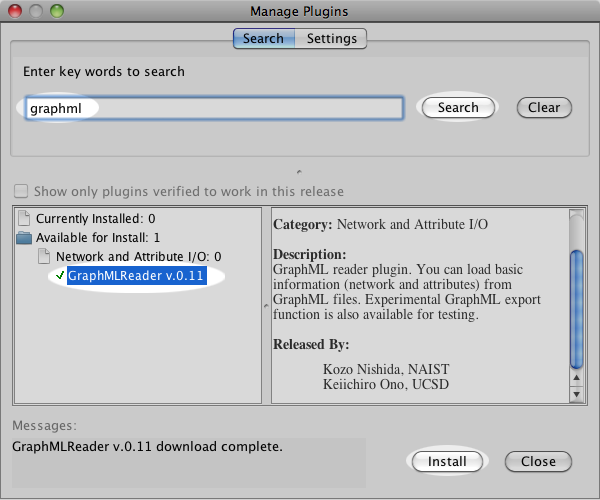

Powerful command line tools to automate basic and advanced analysis not available via the website.Number of query genes is limited only by the amount of memory available.The app follows the look and feel of the GeneMANIA website, but provides more features for power-users: Users may add their own interaction networks and expression profile data to complement or override the default data. The app uses a large database of functional interaction networks from multiple organisms and each related gene is traceable to the source network used to make the prediction. GeneMANIA identifies the most related genes to a query gene set using a guilt-by-association approach. Soinov, "Towards reconstruction of gene networks from expression data by supervised learning", Gen Biol 2003.The GeneMANIA Cytoscape app brings fast gene function prediction capabilities to the desktop. Davis, "A genomewide transcriptional analysis of the mitotic cell cycle", Identification of cell cycle-regulated genes of the yeast saccharomyces cerevisiae by microarray hybridization", Mol Biol Cell 1998, vol. Therefore, these three gene expression data sets may be defined as statistically independent. Methods: cdc15, cdc28, and alpha-factors. These data were synchronized by three different This datasetĬonsiders a set of twenty well-described genes (see Table 1 in ), which encode important proteins for cell-cycle regulation. The microarray dataset of Spellman and Cho for the budding yeast (Saccharomyces cerevisiae) cell-cycle has been selected. Copy \IN \OUT folders into the folder of Cytoscape.

#Cytoscape 2.8 zip file#
RegNet.zip: a zip file that includes Linux/Windows Cytoscape plugin and data example. Isabel A Nepomuceno-Chamorro, Jesus S Aguilar-Ruiz and Jose C Riquelme.Ī screenshot of the Cytoscape plugin SoftRegNet. Inferring gene regression networks with model trees. Furthermore, experimental results show the good performance of REGNET. They are very often more precise than linear regression models because they can add just different linear regressions to separate areas of the search space favoring to infer localized similarities over a more global similarity. Model trees are very useful techniques to estimate the numerical values for the target genes by linear regression functions. REGNET generates gene association networks from gene expression data, and differs from correlation-based methods in that the relationship between one gene and others is calculated simultaneously. This experiment shows that REGNET performs more accurately at detecting true gene associations than the Pearson and Spearman zeroth and first-order correlation-based methods. Second the E.coli transcriptional network (in the Regulon database) is used as control to compare the results to that of a correlation-based method. First, the biological coherence of the results are tested. The performance of our approach, named REGNET, is experimentally tested on two well-known data sets: Saccharomyces Cerevisiae and E.coli data set. For this reason we apply a statistical procedure to control the false discovery rate. Finally, a graph from all the relationships among output and input genes is built taking into account whether the pair of genes is statistically significant. While correlation-based methods analyze each pair of genes, in our approach we generate a single regression tree for each gene from the remaining genes. We propose model trees as a method to identify gene interaction networks. Correlation-based methods are very useful in order to determine whether two genes have a strong global similarity but do not detect local similarities.Results They are typically generated using correlation statistics as pairwise similarity measures.

To infer gene regulatory networks, the first step is to find direct regulatory relationships between genes building the so-called gene co-expression networks. Novel strategies are required in order to handle the huge amount of data produced by microarray technologies. RegNetC: Inferring Regression Networks as a plugin for Cytoscape 2.8.2


 0 kommentar(er)
0 kommentar(er)
